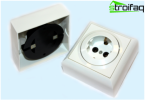What can be as familiar and in demand as lighting? The most beautiful chandelier attracts the eye only at first. And then no one notices her. The light in itself is fraught with interesting opportunities that make life more beautiful. More precisely, not so much the lighting itself, as modern methods of controlling artificial lighting. That is why the connection of a dimmer will interest readers.
Content
- What is a dimmer
- Ways to connect a dimmer
- What are the dimmers
- Use cases for dimmers
What is a dimmer
Previously, rheostats were used to control the brightness of incandescent sources. At that time, no one even thought about saving; it simply wasn’t. This was so before the advent of semiconductor devices – a triac and dinistor, on the basis of which dimmers work. These unpretentious devices are installed everywhere where you need to adjust the brightness of the light..
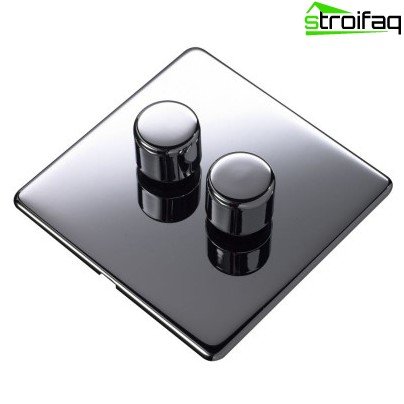
It looks like a dimmer
The dimmer is a miniature device that is mounted instead of a conventional mechanical switch and allows you to smoothly change the brightness of the light. The first regulator was made in the 90s of the 19th century for slowly dimming artificial lighting in the theater. The primacy of this invention belongs to Granville Woods, a self-taught inventor from the USA..
All dimmers are designed to turn on and off the light source and change its intensity. In addition, many models perform other useful functions, such as imitation of presence, automatic shutdown by timer, remote control, smooth shutdown, voice or acoustic control, connection to the Smart Home network. Therefore, before buying, you need to decide why you need to install a dimmer, and what range of services the unit should provide.
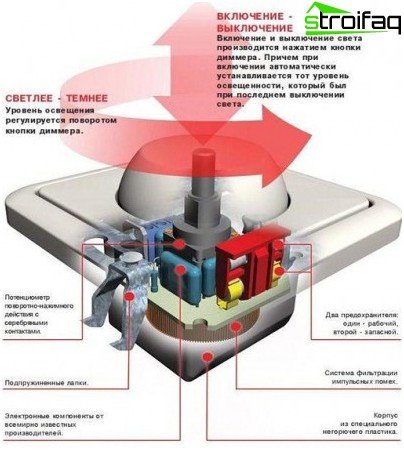
Dimmer construction
In the design of the simplest dimmers there is one rotary knob for regulation and 2 outputs for connection. The device is used to control the brightness of halogen lamps and incandescent lamps. On sale recently appeared dimmers to change the brightness of fluorescent bulbs.
Ways to connect a dimmer
The connection scheme of the dimmers is impossibly simple. They are installed as standard switches – in the installation box. The only condition for manufacturers to connect is the need to connect the terminals to the load and to the phase.
In order for the lamp to light up, it is necessary for the triac to pass a current through itself. This happens when a certain voltage occurs between the electrodes G and A1. The capacitor at the beginning of a positive wave is charged through a potentiometer R, the value of which depends on the speed of the charge. When the voltage on the capacitor reaches a value that is sufficient to open the dinistor and triac, the latter opens. In other words, its resistance becomes low enough and the light will remain on until the end of the half-wave..
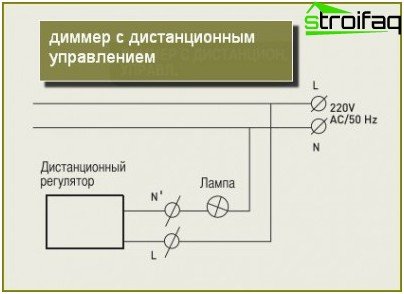
Dimmer connection diagram
The same situation happens with a negative half-wave. It is known that the triac and the diac are symmetrical devices, so it does not matter to them where the current flows through them. It turns out that with an active load, the voltage is a “cut-off” of positive and negative half-waves with a frequency of 100 Hz, following each other. When the bulb is fed by the shortest voltage particles, flicker is noticeable at low brightness. This cannot be said for frequency-controlled dimmers and rheostatic dimmers..
The dimmer connection scheme does not require special details, any triacs can be installed, depending on the load power. The voltage must be at least 400 V, because the instantaneous voltage in the network can reach 350 V. Starting and ending points of ignition, as well as the stability of the lamp, depend on the value of the resistors and capacitors. Dinistors – DB3 and DB4.
There are two ways to connect dimmers: single and group. A single dimmer can be used for one lamp or for several light sources, which are combined into a common group.
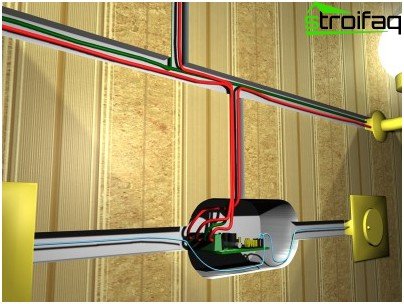
So connect the dimmer
The centers that control the devices can be combined into one circuit, which includes 2 to 6 zones. If you know how to connect a dimmer and control it correctly from one remote control, then you can carry out light zoning of the entire housing.
Another way to use dimmers is as follows. In addition to general lighting, when creating an interior, you can take the opportunity to create spectacular highlights. Using a similar technique, it will turn out to pay attention to certain elements of the decor, that is, highlight worthy interior objects.
What are the dimmers
All dimmers that are commercially available are classified by type and power of lamp as follows:
- Dimmers for halogen bulbs and incandescent bulbs rated for 220 V. Depending on the magnitude of the voltage supplied through the dimmer, the filament of the lamp shines weaker or brighter.
- Dimmers that are designed for low-voltage halogen bulbs fed through transformers. If the light sources are designed for voltages up to 24 V, a transformer is needed, which is able to convert the output voltage of the device to this value. A special transformer is required to provide a soft start. First, a light current is not supplied to the bulb at which its thread is heated, but overloads do not occur.
- Dimmers for LEDs and fluorescent lamps. In this case, you need an electronic choke in the lamp. Electronic ballasts transmit voltages up to 10 V to the lamp by adjusting the light intensity.
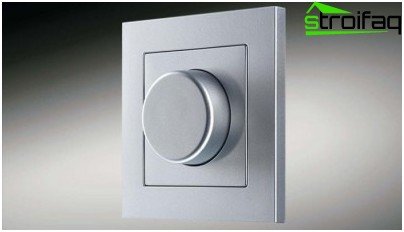
Rotary dimmer
There are touch, rotary and button dimmers. The brightness of the rotary dimmer is set by turning the knob of the potentiometer. Rotary dimmers are cheaper than other devices, and therefore are very popular. The minus of the model lies in the fact that in the memory of the device it is impossible to save the value of the light to start. The start is always made with minimal brightness..
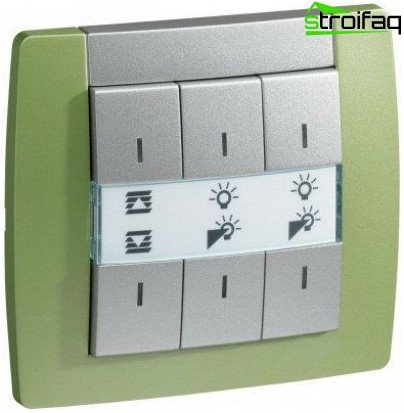
Push button dimmer
A push-button dimmer can be controlled from 3-4 places, the maximum wire length is 10 meters, while the dimmer circuit is critical to interference and interference. There are also multi-channel devices that allow you to simultaneously control the light of several zones by pressing a single button, as well as indicate the minimum level for each of them.
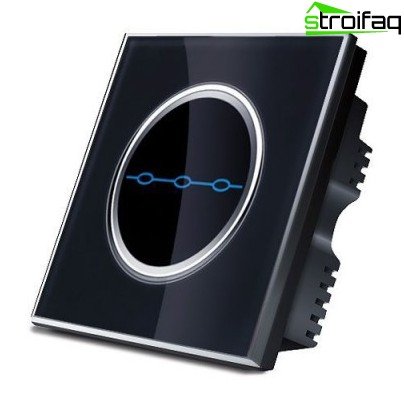
Touch dimmer
Touch dimmers are the most advanced devices. In such models, the brightness adjustment of the lighting occurs due to the light touch of the key, because all control is performed without moving parts. Touch dimmers can be equipped with an infrared receiver for remote control. Some dimmers can control several independent luminaires simultaneously. Two-key touch dimmers can be used to control various types of lamps. The brightness of the light is changed using two keys that are independent of each other..
Use cases for dimmers
Of particular interest is such a function of dimmers as changing the brightness of light sources. There are even physiological reasons for this, because different types of human activity require different illumination. It remains only to type in Google “dimmer how to install”, and then the limitless possibilities of the dimmers will open.
Consider the requirements for lighting the workplace of students. Daylight is enough to complete the lessons, but in the evening you need artificial lighting. What to do at dusk, when there is not enough natural light, and artificial lighting is unnecessary? In this situation, a system is needed that can monitor the current illumination and turn on the light with the desired brightness level.
It is convenient if in the corridor the lighting has 2 brightness levels. At full brightness, it turns on at normal time, at half brightness – at night. Lighting with dimmers is much more pleasant for the eyes. You can also connect bedside sconces to this unit to set the brightness for reading, or use the lamp as a night lamp.
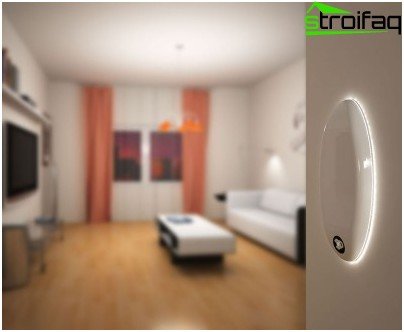
Dimmer in the interior
Lighting with dimmers is a powerful tool in the formation and decoration of the interior. Stage tools provide almost limitless possibilities, for example, when decorating a living room. According to hygiene standards in this room, you need to change the brightness of the light sources, and if you use dimmers, you can achieve an amazing result: you can activate the desired light scene with a single key. It is advisable to have such light scenes for an intimate meeting, a simple lunch or a gala reception.
If a holiday is planned, the lighting can be turned on at all possible brightness, and when the guests are gone, and the tenants want to be alone, the brightness is easily reduced. During the reception of friends, you can illuminate the center of the room, leaving the periphery in the darkness. Management centers combine up to 6 zones.
Against the background of general lighting, dimmers allow accent lighting. Items that are considered worthy of attention require the most careful coverage. It is not necessary to highlight the central group of furniture using lighting. With the help of thoughtful lighting, the main things can be done at first glance, invisible little things that inspire and enliven the interior. Illumination of paintings, niches with favorite vases, a bookcase … Any decorative element or object can come to the main plan if it is provided with light support.
When using dimmers, electricity consumption is significantly reduced – up to 60% and the life of the light sources increases. The useful life of halogen bulbs and incandescent bulbs is not rarely increased twenty times. This is due to the fact that the luminaires operate in mild temperature conditions: a smooth increase in brightness from zero to the desired value, “soft start”.
Dimmer is a very useful device, which will come in handy in any room. These devices allow you to control lighting devices, including light and dimming. The use of dimmers in the interior is considered unlimited, it all depends on the imagination and taste preferences of the person. With any option to connect the regulator, this will bring owners positive emotions, and even significant savings, because such devices reduce energy costs and extend the lamp life by supplying a low voltage to them.


